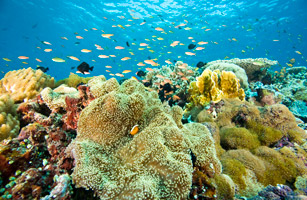
© Stuart Westmorland/Design Pics/Corbis
Science publishes a special issue this week on “Changing Oceans.” Perhaps the most striking article in the issue is a review on “The Impact of Climate Change on the World’s Marine Ecosystems.” The article begins by pointing out how oceans, which currently cover 71% of the earth’s surface, nurtured life on our planet. The paper then goes on to list the drastic and at times horrifying ways that human activities are already driving rapid changes to ocean ecosystems. I briefly caught up with John Bruno of the University of North Carolina, Chapel Hill, who co-authored the review with Ove Hoegh-Guldberg of The University of Queensland, to discuss why oceans, after cradling life for millions of years, may soon turn into giant graves.
Your review includes a laundry list of changes to the ocean, from altered food dynamics to shifting species distribution to disease. It makes for pretty grim, reading, doesn’t it?
Bruno: It is pretty grim. It’s surprising how many physical aspects of the ocean climate change is influencing, well beyond temperature alone. Take the stratification of the ocean. Stratification means there is little mixing of layers at different depths of the ocean. If you have a lot of mixing you have nutrient-rich cold water coming up from the deep into shallow water. Those nutrients are critical for plant growth. And plants in the open ocean are Phytoplankton—small plants that photosynthesize and drive the ocean food web. Stratification changes the amount of Phytoplankton in the water column in the middle of the ocean, and that has implications for fisheries and a whole variety of other things. What’s driving that is changes in current and wind patterns, and that has to do with changes in the overall climate system.
In some areas, though, mixing has increased, right?
Bruno: That’s true, but it’s not all good news there, either. In some places you get “boom phases” during which the plants bloom, then die, and then sink to the bottom. The plant biomass decomposes and is consumed by bacteria, which consumes oxygen, and then you get huge zones on the sea floor where oxygen content is really low and so you get die-offs of crabs and fish and other important species. That’s already happening in some places.
What are some of the other changes brought by climate change?
Bruno: One of the most worrying is the loss of habitat-forming species–the obvious one is coral. Corals are analogous to trees in a forest, and once they die you can see add-on effects on all the other organisms that inhabit the reefs. The loss of these foundation systems on which tens of thousands or hundreds of thousands of species depend can lead to mass extinctions. Climate change is not the only thing driving that, of course–mangrove loss is being driven by shrimp farming.
Are oceans given enough attention in the climate change discussion? How were they covered in the IPCC report?
Bruno: There was very little on oceans in the last IPCC report. A recent study added up the case studies from the report and found that less than 5 percent were from the oceans. There is a couple of groups looking to change that for the next report, which is due out in 2014. Oceans are important for a variety of reasons, of course–they produce 50% of the oxygen we breath and absorb 30% of our carbon emissions.
Is your take home message that, from the data already out there, it’s clear that human activity is already causing major changes in the way the oceans function and support life?
Bruno: A couple of years ago I thought that my role as a scientists was going to be looking at how climate change would be bad for oceans in the future. I never thought I’d be studying it in real-time, especially so early in my career. It’s happening very quickly.


